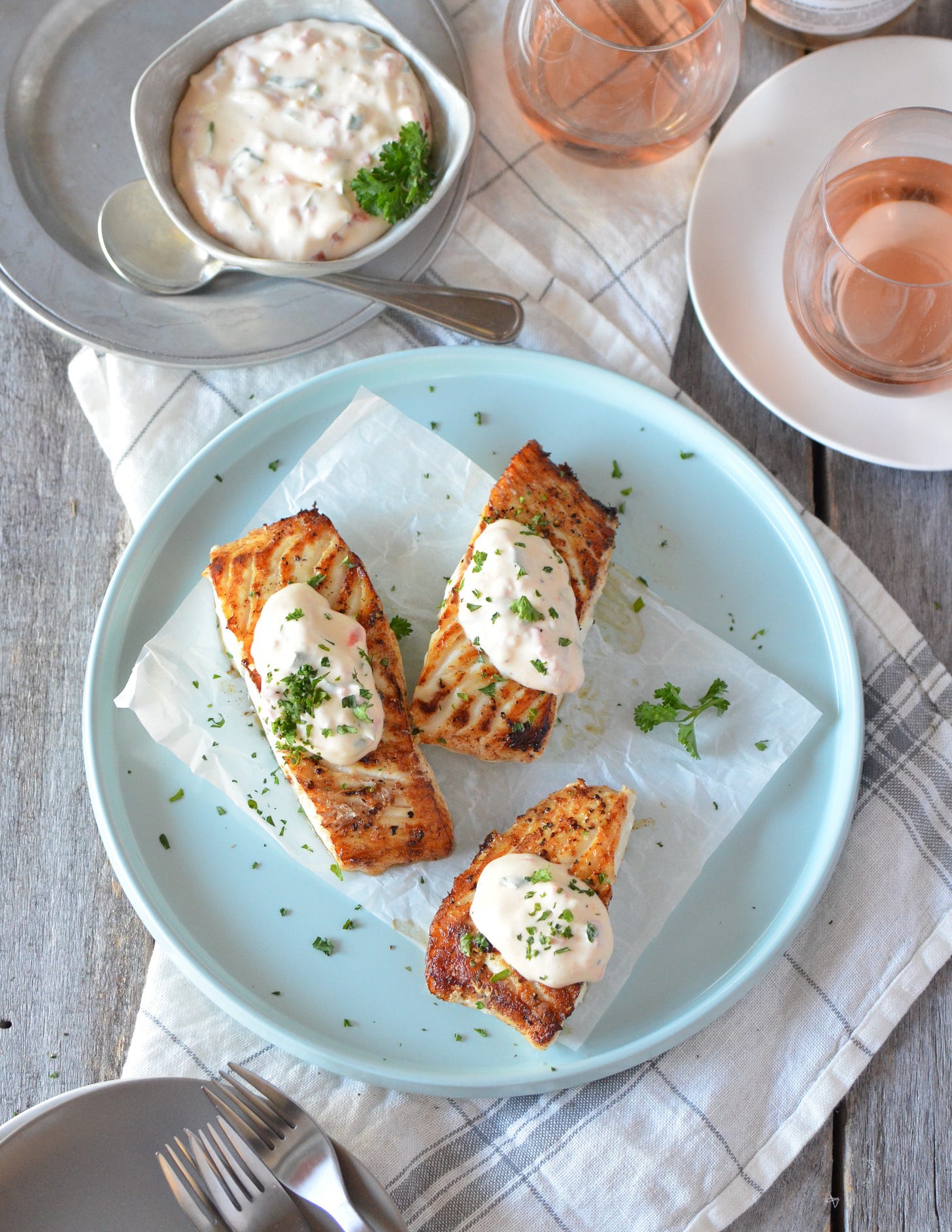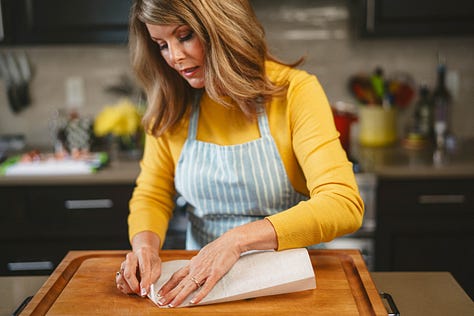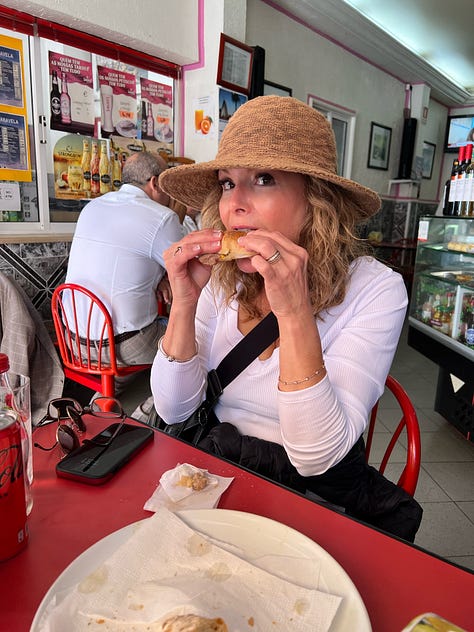How Learning to Cook Changed Everything
and a recipe for Pan Cooked Fish with Whipped Pimento Sauce

I remember the moment it hit me; I couldn’t cook. It felt like someone had flipped off a light switch and left me motionless in the dark. I was in my kitchen, stirring a pan of ground beef, when the familiar scent of garlic and onions sizzling in olive oil drifted through my open window. It happened almost every evening, like clockwork. Those intoxicating wafts of flavor would weave their way into my kitchen, and I’d find myself wishing, longing, that they were coming from my own pan. But they weren’t. They belonged to my sweet neighbor next door, an incredible home cook, and fittingly, Italian. She could probably boil water and make it taste divine.
Meanwhile, my kitchen told a different story. One without the seductive scents of culinary magic. And, if I’m being honest, anything I cooked had the potential to be more of a cautionary tale than a meal.
It wasn’t that I couldn’t follow a recipe, I liked them because they helped me get dinner on the table. But more than anything, I wanted to understand cooking: the instinct for seasoning, the way flavors build upon each other, the magic of transforming simple ingredients into something more, it all felt just out of reach. Even the simple motions of chopping, mincing, stirring at the stove didn’t come naturally. Clearly, I was missing a cooking gene.
Or maybe it wasn’t simply a lack of skill, maybe it was confidence. The kind that lets you trust your instincts, cook without second-guessing, and be bold enough to stray from the recipe.
Yet, despite that uncertainty, something in me was shifting. It was a quiet urge I couldn’t quite name.
At the time, I was in the middle of a career sabbatical, home with my two little girls, trying to figure out my next steps. I wanted to make the most of those moments, and part of that meant making our meals more exciting. But instead of feeling inspired in the kitchen, I felt lost.
It wasn’t enough to to simply follow instructions, I needed to understand why they mattered. Why certain ingredients worked in harmony while others clashed. Why one technique could transform a dish while another left it lifeless. I wanted to play with flavors, to grasp their delicate balance, and their unexpected surprises. Recipes were my safety net, something to cling to so I wouldn’t completely fail.
But what I was searching for ran deeper than just learning to cook, I just didn’t know it yet.
What started as a simple desire to make a meal I truly wanted to eat became something else entirely. Cooking, as it turned out, wasn’t just about food, it was about finding my way forward. I didn’t know it then, but I was on the verge of something that would change everything.
Looking back, I can see how those uncertain steps in the kitchen led me somewhere I never expected, to culinary school, to a new career, to an entirely different version of myself. And that’s the story I want to tell.



Oddly, I don’t have many photos of me cooking, but I seem to have quite a few of me eating. ;)
In the months to come in A Taste of Belonging, I’ll be sharing more glimpses of this journey, stories of how I stumbled (sometimes literally) into the world of cooking, the lessons I learned (some painful, some so hilarious, or bizarre, all I could do was laugh), and, of course, the recipes that became part of my life.
And, with each story, there is always a recipe. Because food is never just food. It’s a memory, sanctuary, transformation, and love. It is a thread stitching the past to the present, a quiet whisper of belonging.
In these challenging times, I’m sending you love, light and deep peace. May this space be a gentle pause, a breath of fresh air amid the noise.
Karista
Food memories are often the most enduring. Filled with moments of kindred spirit, sanctuary… love.
Karista Bennett

One of my favorite culinary classes was seafood. Learning how to filet and skin a fish, properly pan-cook or roast seafood, I felt like a kid in a candy store. So it’s no surprise that my second cookbook is all about seafood. But I wanted this book to be more than just a collection of recipes; I wanted it to be instructional, a guide that gives home cooks the confidence, techniques, and knowledge they need to successfully cook fish at home.
To do that, I included a first chapter called Seafood 101, packed with essential tips on cooking techniques, different types of seafood, and the best ingredients to pair with them. I also cover sourcing, thawing, and preparation methods to help demystify cooking fish. And to make things even easier, I structured my book, For the Love of Seafood, by difficulty level—Easy Like a Weeknight, Show off Those Skills (modestly easy), and Just a Little Fancy (a little more time in the kitchen).
This lovely recipe, comes from the Easy Like a Weeknight chapter and is so simple that dinner can be ready in under 30 minutes. The fish can be roasted, pan-cooked, grilled or even poached. No matter the method, the sauce is the perfect complement, adding just the right touch of flavor to elevate the dish.
Pan-Cooked Fish with Whipped Pimento Sauce
Serves 4-6
Ingredients
4 ounces cream cheese
4 ounces heavy cream
1-2 cloves garlic, minced
4-ounce jar diced pimentos, strained
3 tablespoons sliced green onions
Salt and pepper to taste
A squeeze of lemon to taste (optional)
1 ½-2 lbs. fish such as cod, rockfish, haddock, halibut, snapper, petrale sole or flounder. Cut into 4-6 pieces. Patted dry with a paper towel and make sure it’s been out of the fridge for at least 15 minutes
Corn starch or flour for dusting
Salt and pepper
Oil for pan cooking
Directions
In an electric mixer or with a handheld mixer, whip the cream cheese until soft, and then add the heavy cream. Continue to whip until light and fluffy.
Fold in the garlic, pimentos, green onions and a teaspoon of fresh lemon juice if desired. Season to taste with salt and pepper.
Place a large skillet over medium high heat. Add enough oil to coat the bottom of the skillet, about 2 tablespoons. Season the fish with salt and pepper then lightly dust it in flour or corn starch. Shake the excess off the fish.
When the oil is hot, but not smoking, add the fish (flesh side down if it has skin on it) to the skillet. If the skillet is too hot, turn the heat down. Let the fish brown on the bottom, allowing it to cook at least 2/3 of the way through. You’ll see it become slightly opaque on the sides. About 5-6 minutes depending on the thickness of the fish. Remember the rule of thumb, fish cooks about 10 minutes for every inch of thickness.
With a fish spatula, gently lift the fish off the pan and flip to the other side. Let it cook until golden on the bottom and the fish begins to flake or sperate a bit on the top. Transfer to a plate or platter and serve with a dollop of the pimento sauce.
NOTE: Delicate fish like sole or flounder may benefit from medium to medium high heat to prevent breaking apart. However, more firm fish like salmon and halibut can handle higher heat for a crispier crust.
When cooking fish, remember that, like meat and poultry, it will finish cooking when taken out of the pan. So I take my fish off the heat just before I think it’s done.



Karista, I so enjoyed reading your Learning How to Cook entry. Cooking and assisting with cooking classes and wonderful instructors like you certainly added a sense of fulfillment and appreciation. It addition to how the culinary world changed you, for me it also contributed a sense of community and caring.
Love your writings - and of course, your recipes!!
Thanks for sharing! I plan on trying this. Also remember the journey you have taken! Makes me smile!😊